新概念英语第一册L127-128精讲
- 格式:doc
- 大小:106.49 KB
- 文档页数:6
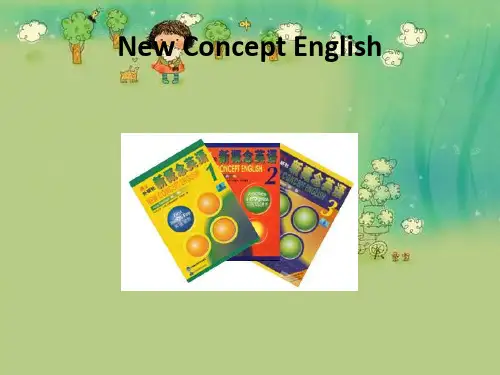
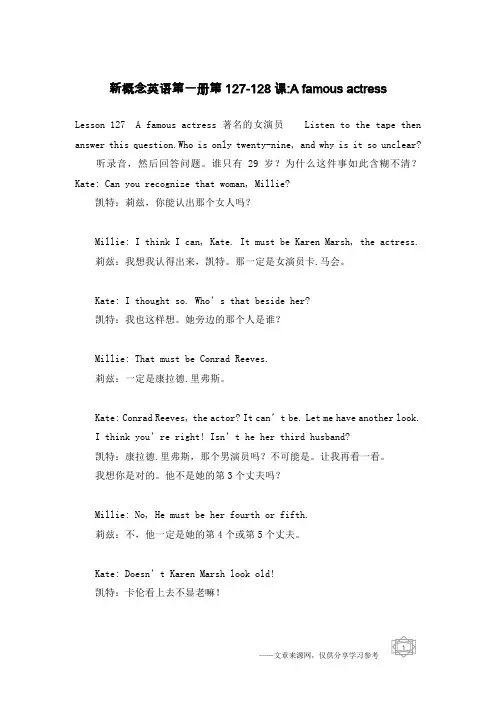
新概念英语第一册第127-128课:A famous actressLesson 127 A famous actress著名的女演员Listen to the tape then answer this question.Who is only twenty-nine, and why is it so unclear?听录音,然后回答问题。
谁只有29岁?为什么这件事如此含糊不清?Kate: Can you recognize that woman, Millie?凯特:莉兹,你能认出那个女人吗?Millie: I think I can, Kate. It must be Karen Marsh, the actress.莉兹:我想我认得出来,凯特。
那一定是女演员卡.马会。
Kate: I thought so. Who’s that beside her?凯特:我也这样想。
她旁边的那个人是谁?Millie: That must be Conrad Reeves.莉兹:一定是康拉德.里弗斯。
Kate: Conrad Reeves, the actor? It can’t be. Let me have another look.I think you’re right! Isn’t he her third husband?凯特:康拉德.里弗斯,那个男演员吗?不可能是。
让我再看一看。
我想你是对的。
他不是她的第3个丈夫吗?Millie: No, He must be her fourth or fifth.莉兹:不,他一定是她的第4个或第5个丈夫。
Kate: Doesn’t Karen Marsh look old!凯特:卡伦看上去不显老嘛!Millie: She does, doesn’t she! I read she’s twenty-nine, but she must be at least forty.莉兹:是的,谁说不是呢!我从报上看到她是29岁,但她一定至少有40岁了。
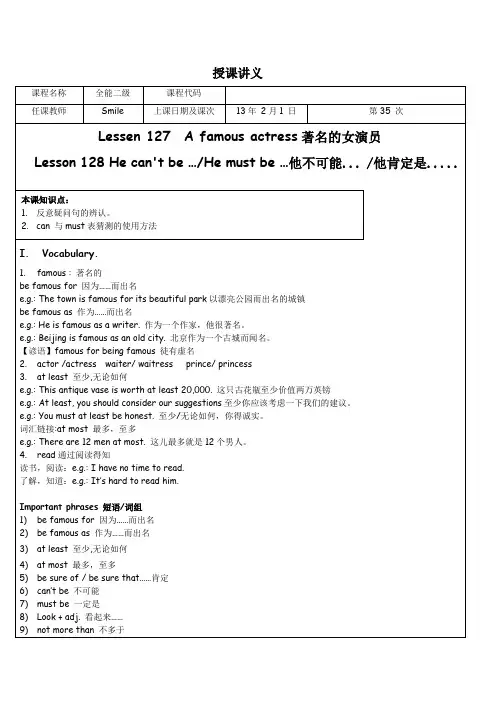
授课讲义I’will,应该放在前面。
It takes a long time. take用于花费时间。
It takes sb. sometime to do sth 做某事需要花费某人多长时间It took me a week to finish this work. 我完成这项工作花了一周的时间。
We might not go anywhere. 我们可能哪也不去,而不是我们不可能去那。
We can’t go anywhere。
In the end adv.最后。
等于at last adv.最后=at the end of sth 在…结尾。
Expressions1. must和have to的用法两者都表示必要性,两者的主要区别在于:1. must表示主观意愿,而have to表示客观事实。
2. must 只用于现在时,而过去时用had to,将来时用will have to。
3. must 不用于否定句,否定句用needn’t 不必要或don’t need to。
mustn’t的意思是不允许,禁止。
2. 情态动词表示推测:情态动词表示推测的有:must一定、could很有可能、may可能、might有一些可能。
它们的用法是:1. 它们表示推测只能用于肯定句之中,而疑问句用can,否定句用can’t不可能。
Can the he stay at home at the moment? 现在他能在家么?He must be staying at home. 他一定在家。
He can’t be staying at home. 他不可能在家。
2. 情态动词用原形,表示对现在或将来的情况时行推测。
He must be a teacher. 他可能是一名老师。
(系表)We may travel by sea next month. 下个月,我们可能乘船旅行。
3. 情态动词用be doing,表示对现在的情况进行推测。

新概念一册四期Lesson 127-128知识点总结开始啦!一、词汇1. famous 【形容词】著名的be famous for….. 因….而出名例句:Jackie Chan is famous for his Kung Fu movies.成龙因他的功夫电影而出名。
2. actress 【名词】女演员例句:The actress who looks beautiful in the picture is Liu Yifei.照片中那位看起来很漂亮的女演员是刘亦菲。
3. actor 【名词】男演员Tom Cruise is one of the most famous actors in the world.汤姆克鲁斯是世界上最著名的男演员之一。
4. at least 至少例句:Oh, my god ! We have at least 5000 enemies!I must go home now !噢,上帝!我们至少有五千名敌人!我现在必须回家!拓展:at most 最多;至多;充其量Mommy says that I can have at least five candies. Yes ! 妈妈说我最多可以吃五颗糖果。
耶!5. read 【动词】通过阅读得知I read from the newspapers that the moon is going to fall tomorrow. Oh , it’s so horrible !我刚刚从报纸上看到,明天月球要掉下来了。
噢,太可怕了!二、语法重点本周我们学习到了部分情态动词(如can may must 等)的新用途--------表示推测语气。
根据推测语气中对推测事物的确定程度,我们将它们从小到大排列:might--------大概,估计may---------也许can----------可能must---------一定;肯定以上情态动词加上be动词,例如must be(一定是)can be (可能是) might be (大概是) 例句:She must be no more than 25. She looks so young.她一定没超过25岁。

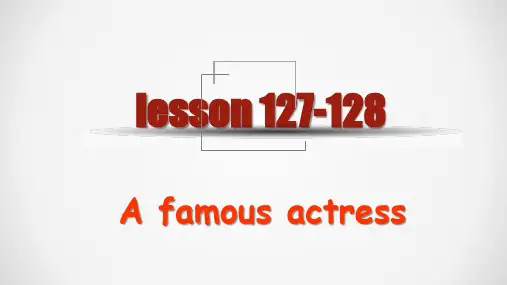
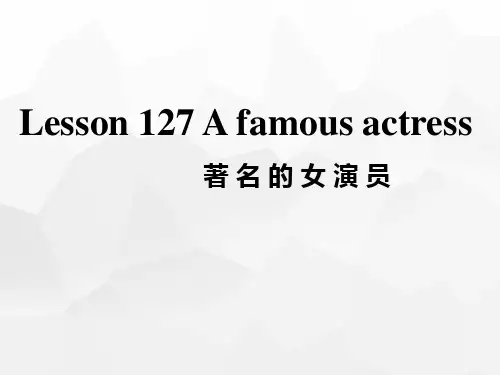
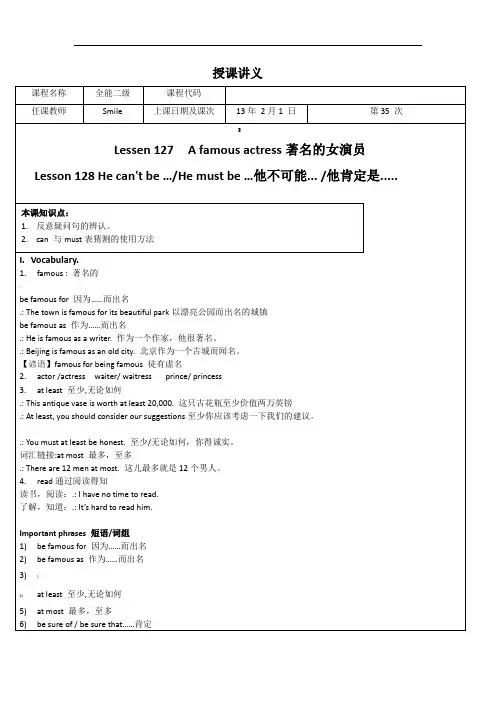
授课讲义I’ll certainly be more careful. 我以后一定会多加注意。
这里面助动词是will,应该放在前面。
It takes a long time. take用于花费时间。
It takes sb. sometime to do sth 做某事需要花费某人多长时间It took me a week to finish this work. 我完成这项工作花了一周的时间。
We might not go anywhere. 我们可能哪也不去,而不是我们不可能去那。
We can’t go anywhere。
In the end adv.最后。
等于at last adv.最后=at the end of sth 在…结尾。
Expressions1. must和have to的用法|两者都表示必要性,两者的主要区别在于:1. must表示主观意愿,而have to表示客观事实。
2. must 只用于现在时,而过去时用had to,将来时用will have to。
3. must 不用于否定句,否定句用needn’t 不必要或don’t need to。
mustn’t的意思是不允许,禁止。
2. 情态动词表示推测:情态动词表示推测的有:must一定、could很有可能、may可能、might有一些可能。
它们的用法是:1. 它们表示推测只能用于肯定句之中,而疑问句用can,否定句用can’t不可能。
Can the he stay at home at the moment 现在他能在家么He must be staying at home. 他一定在家。
He can’t be staying at home. 他不可能在家。
2. 情态动词用原形,表示对现在或将来的情况时行推测。
He must be a teacher. 他可能是一名老师。
(系表)We may travel by sea next month. 下个月,我们可能乘船旅行。
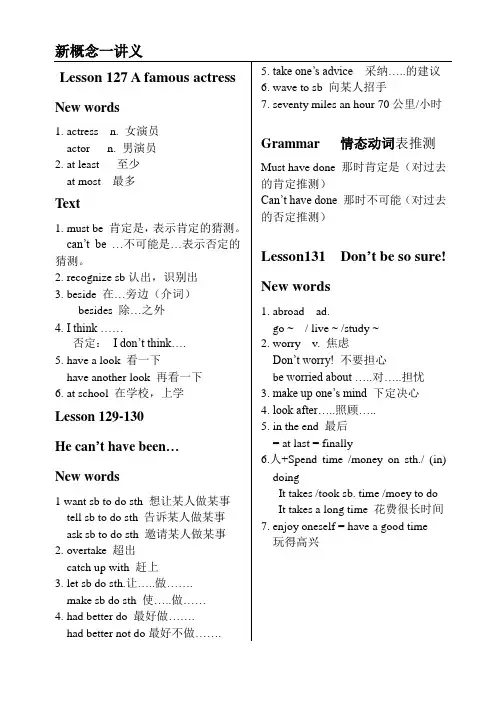

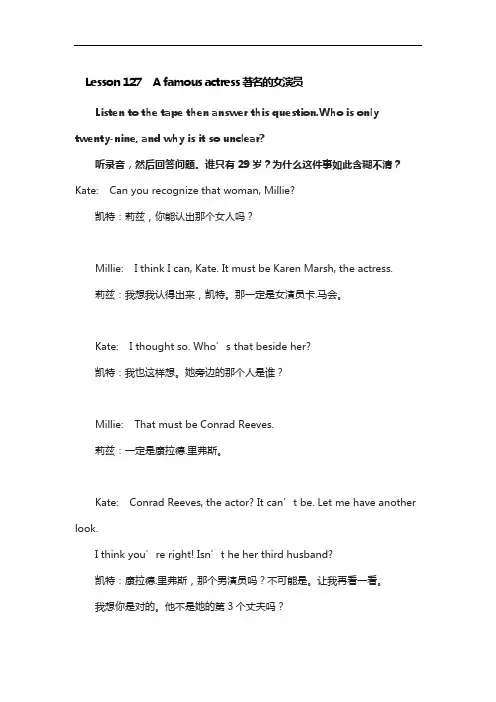
Lesson 127 A famous actress著名的女演员Listen to the tape then answer this question.Who is only twenty-nine, and why is it so unclear?听录音,然后回答问题。
谁只有29岁?为什么这件事如此含糊不清?Kate: Can you recognize that woman, Millie?凯特:莉兹,你能认出那个女人吗?Millie: I think I can, Kate. It must be Karen Marsh, the actress.莉兹:我想我认得出来,凯特。
那一定是女演员卡.马会。
Kate: I thought so. Who’s that beside her?凯特:我也这样想。
她旁边的那个人是谁?Millie: That must be Conrad Reeves.莉兹:一定是康拉德.里弗斯。
Kate: Conrad Reeves, the actor? It can’t be. Let me have another look.I think you’re right! Isn’t he her third husband?凯特:康拉德.里弗斯,那个男演员吗?不可能是。
让我再看一看。
我想你是对的。
他不是她的第3个丈夫吗?Millie: No, He must be her fourth or fifth.莉兹:不,他一定是她的第4个或第5个丈夫。
Kate: Doesn’t Karen Marsh look old!凯特:卡伦看上去不显老嘛!Millie: She does, doesn’t she! I read she’s twenty-nine, but she must be at least forty.莉兹:是的,谁说不是呢!我从报上看到她是29岁,但她一定至少有40岁了。
Lesson 127-128 A famous actress 著名的女演员Key words[词汇]famous adj. 著名的 actress n. 女演员 at least 至少actor n. 男演员 read (read/read) v. 通过阅读得知★famous adj. 著名的① adj. 著名的;出名的She’s a very famous actress.be famous for 以……而出名She is famous for her beauty.be famous as 作为……而出名He is famous as a writer.fame n. 名誉,名声② adj.(口)第一流的;极好的To my surprise, he had a famous appetite. 让我感到惊讶的是,他有着极好的胃口。
This is famous weather for a stroll. 这是散步最理想的天气。
★at least 至少①至少,其反义词—at most最多,最大This antique vase is worth at least 20,000. 这只古花瓶至少价值两万英镑。
At least, you should consider our suggestions. 至少你应该考虑一下我们的建议。
②反正;无论如何;不管怎样He has no plans to go abroad yet, at least as far as I know.他尚未有出国的计划,至少据我所知是这样的。
That pa rty wasn’t exciting at all, but at least it filled the time.那个聚会一点儿都不令人兴奋,但不管怎样,它使人打发了那段时光。
拓展:least of all 最不…,尤其不…at best 充其量,至多,最佳状态 at worst 在最坏的形式下,在最保守的估计下,在最不利的解释下★read (read/read) v. 通过阅读得知My son can read the clock. 我的儿子会看时钟。
新概念课堂笔记第一册Lesson127-128 Word Studyfamous【用法】adj. 闻名的【词组】be famous for …因……而出名be famous as …作为……而出名【同义】well-known adj. 出名的【扩展】fame n. 名气,名声【例句】Hawaii is famous for its beautiful beaches. 夏威夷因其漂亮的海滩而出名。
Mark Twain is famou s as a writer. 马克吐温是作为一名作家而出名。
She is a very famous actress. 她是一位专门出名的女演员。
actress【用法】n. 女演员(pl.)actres ses【扩展】actor n. (男)演员act v. 表演;行动at least【用法】至少【扩展】at most 至多,最多,充其量【例句】This vase is worth at least 20,000 pounds. 这支花瓶至少价值两万英镑。
That party wasn’t e xciting at all, but at least it filled the time. 那个聚会一点儿都不令人兴奋,但不管如何样,它使人打发了那段时刻。
There were at most t wenty people in the classroom. 教室里最多只是20人。
NamesLiz /liz/ 莉兹Karen Marsh /ˈkærən/ / mɑ:ʃ/ 卡伦·马什Conrad Reeves /ˈkɔnræd/ /ri:vz /Text ExplanationIt must be Karen Marsh, the actress. I thought so.【译文】那一定是女演员卡伦·马什。
我也如此想。
【用法】○1the actress作Karen Marsh的同位语。
新概念英语第一册第127-128课:Afamousactress预览说明:预览图片所展示的格式为文档的源格式展示,下载源文件没有水印,内容可编辑和复制Lesson 127 A famous actress著名的女演员Listen to the tape then answer this question.Who is only twenty-nine, and why is it so unclear?听录音,然后回答问题。
谁只有29岁?为什么这件事如此含糊不清?Kate: Can you recognize that woman, Millie?凯特:莉兹,你能认出那个女人吗?Millie: I think I can, Kate. It must be Karen Marsh, the actress.莉兹:我想我认得出来,凯特。
那一定是女演员卡.马会。
Kate: I thought so. Who’s that beside her?凯特:我也这样想。
她旁边的那个人是谁?Millie: That must be Conrad Reeves.莉兹:一定是康拉德.里弗斯。
Kate: Conrad Reeves, the actor? It can’t be. Let me have another look.I think you’re right! Isn’t he her third husband?凯特:康拉德.里弗斯,那个男演员吗?不可能是。
让我再看一看。
我想你是对的。
他不是她的第3个丈夫吗?Millie: No, He must be her fourth or fifth.莉兹:不,他一定是她的第4个或第5个丈夫。
Kate: Doesn’t Karen Marsh look old!凯特:卡伦看上去不显老嘛!Millie: She does, doesn’t she! I read she’s twenty-nine, but she must be at least forty.莉兹:是的,谁说不是呢!我从报上看到她是29岁,但她一定至少有40岁了。
授课讲义v1.0 可编辑可修改根据汉语补全句子1)他一定知道点什么。
He ________ _______ something about it.2)萨利不可能很大年纪。
她大约25岁,不是吗Sally _______ ________ _______ _______. She is about 25, isn't she3)我自己现在还没29岁呢。
I'm ________ _______ ________ twenty-nine myself.4)那不可能是玛丽。
她在住院。
That _______ _______ ________. She is _______ ________.5)你一定是渴了。
喝点东西吧。
You ________ ________ ________. Have something ________ ________.下列表示建议的情态动词:必须must、have to应该had better、ought to、should可以can、would、may、wouldI’ll certainly be more careful. 我以后一定会多加注意。
这里面助动词是will,应该放在前面。
It takes a long time. take用于花费时间。
It takes sb. sometime to do sth 做某事需要花费某人多长时间It took me a week to finish this work. 我完成这项工作花了一周的时间。
We might not go anywhere. 我们可能哪也不去,而不是我们不可能去那。
We can’t goanywhere。
In the end adv.最后。
等于at last adv.最后= at the end of sth 在…结尾。
Expressions1. must和have to的用法两者都表示必要性,两者的主要区别在于:1. must表示主观意愿,而have to表示客观事实。
授课讲义
I’will,应该放在前面。
It takes a long time. take用于花费时间。
It takes sb. sometime to do sth 做某事需要花费某人多长时间
It took me a week to finish this work. 我完成这项工作花了一周的时间。
We might not go anywhere. 我们可能哪也不去,而不是我们不可能去那。
We can’t go anywhere。
In the end adv.最后。
等于at last adv.最后=at the end of sth 在…结尾。
Expressions
1. must和have to的用法
两者都表示必要性,两者的主要区别在于:
1. must表示主观意愿,而have to表示客观事实。
2. must 只用于现在时,而过去时用had to,将来时用will have to。
3. must 不用于否定句,否定句用needn’t 不必要或don’t need to。
mustn’t的意思
是不允许,禁止。
2. 情态动词表示推测:
情态动词表示推测的有:must一定、could很有可能、may可能、might有一些可能。
它们的用法是:
1. 它们表示推测只能用于肯定句之中,而疑问句用can,否定句用can’t不可能。
Can the he stay at home at the moment? 现在他能在家么?
He must be staying at home. 他一定在家。
He can’t be staying at home. 他不可能在家。
2. 情态动词用原形,表示对现在或将来的情况时行推测。
He must be a teacher. 他可能是一名老师。
(系表)
We may travel by sea next month. 下个月,我们可能乘船旅行。
3. 情态动词用be doing,表示对现在的情况进行推测。
He must be having a lot of money. 他一定有很多钱。
Jim may be playing the basketball. 吉姆可能正在打篮球。
4. 情态动词用have done,表示对过去的情况进行推测。
It must have rained yesterday. 昨天一定下雨了。
I can’t have been late yesterday. 我昨天不可能迟到。
She could have phoned you last night. 她昨晚应该给你打电话了。
He must have stayed at home when we arrived. 当我们到达的时候,他一定在家。
5. 情态动词用have been doing,表示对过去正在进行的动作或过去一直进行的动作进行推测。
She may have been doing his homework last night. 昨天晚上,他可能一直在写作业。